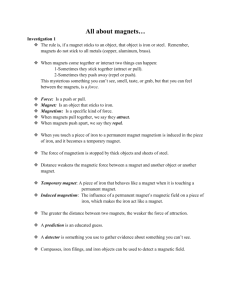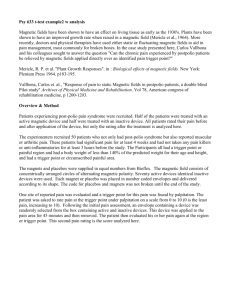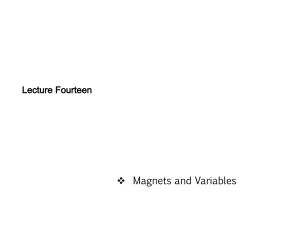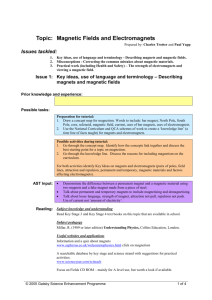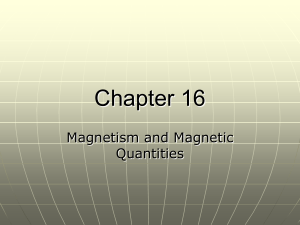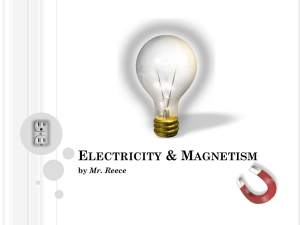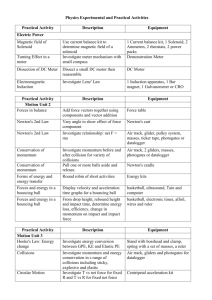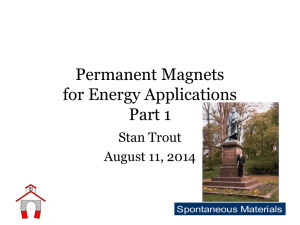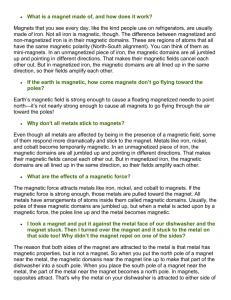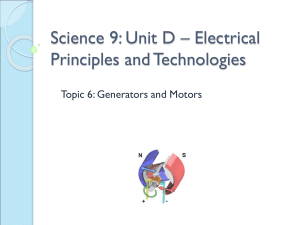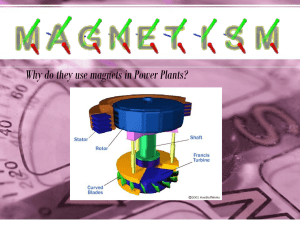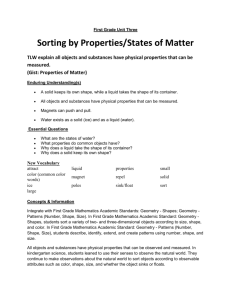Document
advertisement
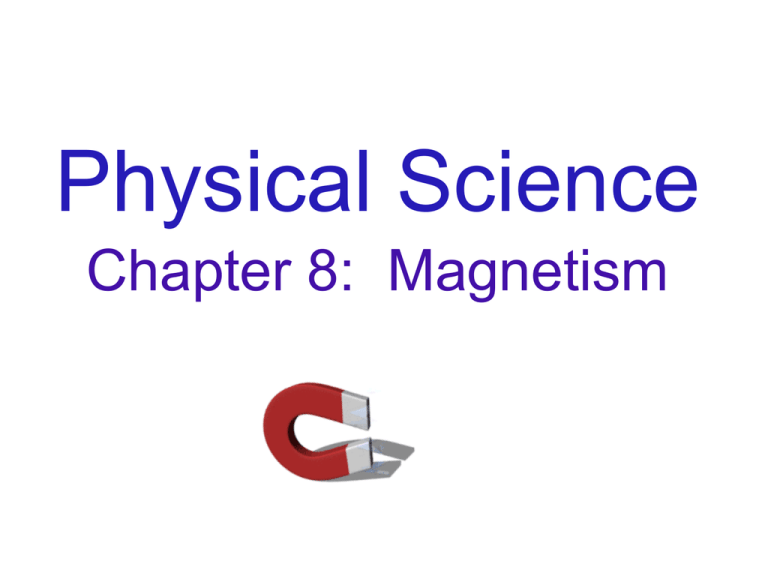
Physical Science Chapter 8: Magnetism • A magnet is a device which attracts iron or other magnets, and produces a magnetic field around it’s body. The term magnetism refers to the properties and interactions of magnets. • A magnetic field is a force field present around a magnet which exerts a force (a push or a pull) on other magnets or magnetic materials. • In the picture, the closer the lines the greater the magnetic force. The force is greatest next to the poles. A magnetic pole is the north (+) or south (-) end of a magnet where the force is the greatest. • Opposite poles of 2 different magnets produce an attractive force, while the same poles repel each other. • A magnetic field causes a magnet to align in the direction of the opposite pole. So the north end of the compass (device used to identify the poles of a magnetic field) aligns with the south end of the magnet. • As you already know, the earth behaves like a large magnet. So the poles of a compass line up with the poles of the earth. However, the north pole on earth (arctic region) is actually the magnetic south end. That is why the north end of a compass still aligns in that direction. • Different materials can become magnets or are effected by magnets. Iron is the most common, but cobalt and nickel have similar properties. • The atoms of these elements are slightly magnetic. Individually, this produces no noticeable effect. But if the atoms all align with each other, then the metal will display magnetic properties. N N S S • These atoms can be made to align by either passing an electric current through the material, or by placing the material next to a magnet. These methods, however, will only create temporary magnets. • Permanent magnets are created by placing material, such as iron, into a very strong magnetic field. This will allow the material to maintain the magnetic properties even after being removed from the field. Neodymium magnets are the strongest magnets in the world. • A warning on the packaging of the magnet shown below cautions that 2 magnets of this size should be kept separate, or will risk shattering upon attraction. • The magnet must be shipped by ground direct because it’s magnetism has been know to interfere with aircraft instrumentation and electronic devices at the shipping companies. • Large neodymiums have been know to break bones as they come together. • Is the strength of a magnet determined by it’s size? • Because magnetism can be created by electrons in atoms, and electricity is created by the flow of electrons, it stands to reason that an electric current can produce a magnetic field. • When this electromagnetic field is imparted to an object, such as an iron bar, then an electromagnet is formed. • An electromagnet is a temporary magnet created by coiling a wire around a metal core, and passing a current through the wire. • The coil of wire is called the solenoid, and the metal inside is called the core (pg. 232). • Do you think electromagnets run on alternating current, direct current, or either? Hmmmm….. • Electromagnets can be found in speakers, motors, cranes, and many other devices. • A metal detector is a type of electromagnet. Electric current passes though a coil of wire wrapped around a metal loop, creating the electromagnet. As the magnet is moved over a metal object, the object creates interference in the magnetic field. This interference is detected by the control box, which produces an audible signal. • Where else might you see another electrical device which works on similar technology? • An electric transformer is a device which increases or decreases the voltage of a circuit. These also work on the concept of electromagnetism. • Electromagnetic levitation is a relatively new application of electromagnets. In electromagnetic levitation, a train or other vehicle is supported and propelled by the repulsive forces ( + and + or – and -) of permanent and electromagnets. • Strong permanent magnets on the bottom of the train are repelled by the electromagnets in the track. This supports the train, and by allowing the electromagnetic current to travel, the train is in turn pushed along. • What are some advantages that mag-lev tracks would have over ordinary tracks? • Electromagnets can also be used to measure an electric current. Devices which do this are called galvanometers. • Many spring gauges are simple forms of galvanometers. • An electric motor is a device which converts electricity to mechanical energy. • An electromagnet turns inside of a permanent magnet. By changing the direction of the current, the poles will keep switching between N and S, and therefore cause the electromagnet to continually rotate. (pg. 236) • Electric motors are used in most household appliances which convert electricity into motion. • Electric generators do just the opposite. They convert mechanical energy into electricity. • They do this through a process of electromagnetic induction. This is where an electric current is generated by manually changing a magnetic field. Magnets and Your Health For years, it has been claimed by some that magnetic fields can effect a persons health. And while it is know that adverse health effects, such as dizziness, nausea, and headaches can been caused by strong magnetic fields, some believe that magnets also possess healing powers. This however, has not been scientifically proven. • In the realm of proven medical technology however, magnets and magnetism do have their place. • Magnetic resonance imaging (MRI) uses magnetism and radio waves to map the inside of a person’s body. • Soft tissue, fluids, and other body parts and materials can be seen in 2 or 3 dimensions to help identify and diagnose problems within the body. • Andy was looking at some different fuses in his dad’s toolbox, and noticed a great variety of filaments. Why do you think the filaments differ so much in shape and/or size? • Kevin was curious why some conductors, like an extension cord, allow electricity to pass right through, while others like a heating coil get really hot when the electricity goes through. • The more resistance in a conductor, the more heat is generated.





